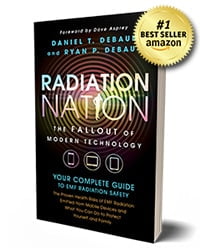Your cart is currently empty!

Electromagnetic Hypersensitivity (EHS) from Electromagnetic Fields (EMFs)
Last Updated on October 4, 2023

There is a growing awareness that Electromagnetic Fields (EMFs) consisting of Extremely Low Frequency (ELF) and higher energy Radio Frequency (RF) radiation found in our environment can be less tolerated by some than others.
The intolerance can be identified by medical symptoms, even when exposures of Electromagnetic Fields (EMFs) are at low levels. The reaction to these radiations is referred to as Electromagnetic Hypersensitivity (EHS), but is also known as ElectricalSensitivity (ES) in less extreme cases.
Most often, it is the non-ionizing lower frequency EMF radiation, rather than highest frequency radiation that sufferers tend to complain about. This Electromagnetic Field (EMF) phenomenon is only beginning to be recognized by the medical or scientific communities.
A Netflix Docuseries released in 2019, called “Afflicted,” follows a woman named Carmen who has EHS. While the Netflix series tries not to legitimize her illness, it is clear that her suffering is caused by electronic devices.
The medical symptoms of Electromagnetic Hypersensitivity (EHS) are sleeping disorders, skin problems, rashes, burning feelings, muscle aches, as well and other health issues. What can’t be ignored is that many electrohypersensitive sufferers find EMF disabling.
Electromagnetic Hypersensitivity (EHS) Symptoms
In 1991, a study conducted by William J. Rea concluded that there was “strong evidence that electromagnetic field sensitivity exists.” While evidence goes back to before mobile technology was even a commonality, EHS is still a hard topic to study and medically diagnose.
Electromagnetic Hypersensitivity (EHS) sufferers seem to react differently to radiating sources with no real consistent response to exposure. For example, those affected by WiFi may not be affected in the same way as other EHS sufferers. In fact, with our environment filled with so many varying radiation sources such as laptop computers, cell phones, power lines, microwave ovens and other electronic devices, it is difficult to determine what source influences what symptom and at what frequency.
As a result, data collected on Electromagnetic Hypersensitivity (EHS) shows little consistency in the severity of symptoms between sufferers.
In 2001 an EMF survey found that people identify symptoms more frequently to mobile phone base stations (74%), followed by mobile phones (36%), cordless phones (29%) and power lines (27%). This data offered no insight between EMF exposure and human health.
In 2005, a Health Protection Agency report noted there is an overlap in many sufferers with symptoms including chronic fatigue syndrome and autism.
The EMF Safety Network’s 2019 EMF Health Effects survey measured different health effects people felt as a result of using technology. Of 876 respondents, 27.5% described themselves as: “EMF Injured – injured by electromagnetic fields and/or wireless radiation.” With many reporting minor or temporary symptoms such as aches and pains, some respondents indicated that cancer, reproductive problems, and seizures are things they believe were caused by chronic EMF exposure.
Of the respondents, 49.3% described themselves as aware that EMF radiation affects your health or makes you feel unwell, and 19.1% described themselves as having electromagnetic radiation sickness, a severe and chronic condition.
While surveys such as these cannot establish a scientific link, it does show the multitude of people who claim to be negatively affected by technology.
These mild to severe symptoms include irregular heartbeat, headache, skin problems, fatigue, dizziness, and memory problems from EMF exposure.
In Sweden one report concludes that as many 10% of those exposed to high doses of EMFs took sick leave, retired early, or collected a disability pension. This is compared to only 5% of the general population.
Electromagnetic Hypersensitivity (EHS) sufferers don’t just consider EHS symptoms annoying, but find the symptoms significantly impact their quality of life.
Electromagnetic Hypersensitivity (EHS) Studies
To better understand Electromagnetic Hypersensitivity (EHS), over 30 Electromagnetic Field (EMF) experiments were reviewed in 2005, with the conclusion “The symptoms described by ‘electromagnetic hypersensitivity’ sufferers can be severe and are sometimes disabling.
However, it is difficult to show under blind conditions that exposure to electromagnetic fields can trigger these symptoms. This suggests that ‘electromagnetic hypersensitivity’ is unrelated to the presence of electromagnetic fields, although more research into this phenomenon is required.”
Even so, the vast number of people claiming their symptoms and illnesses are directly related to their proximity to EMF-emitting devices cannot be ignored.
A study by Rubin et al., known as the Essex study, used methodology and analysis that others in the industry questioned. In response, Rubin and his colleagues made it clear that their work in no way characterized the long-term effects of exposure to electromagnetic fields. Their study concentrated on near term reactions to exposure and found bodily reactions to EMF occurred within minutes of exposure.
Conclusion
Prolonged EMF exposure has been linked to specific health symptoms known as Electromagnetic Hypersensitivity (EHS). If you may think you sufferer from EHS, consider using an EMF radiation shield to minimize exposure to the body.
Related Posts
None found























































